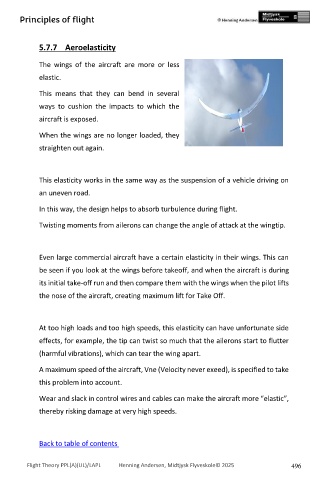Page 496 - PPL-engelsk 2025
P. 496
Principles of flight
5.7.7 Aeroelasticity
The wings of the aircraft are more or less
elastic.
This means that they can bend in several
ways to cushion the impacts to which the
aircraft is exposed.
When the wings are no longer loaded, they
straighten out again.
This elasticity works in the same way as the suspension of a vehicle driving on
an uneven road.
In this way, the design helps to absorb turbulence during flight.
Twisting moments from ailerons can change the angle of attack at the wingtip.
Even large commercial aircraft have a certain elasticity in their wings. This can
be seen if you look at the wings before takeoff, and when the aircraft is during
its initial take-off run and then compare them with the wings when the pilot lifts
the nose of the aircraft, creating maximum lift for Take Off.
At too high loads and too high speeds, this elasticity can have unfortunate side
effects, for example, the tip can twist so much that the ailerons start to flutter
(harmful vibrations), which can tear the wing apart.
A maximum speed of the aircraft, Vne (Velocity never exeed), is specified to take
this problem into account.
Wear and slack in control wires and cables can make the aircraft more “elastic”,
thereby risking damage at very high speeds.
Back to table of contents
Flight Theory PPL(A)(UL)/LAPL Henning Andersen, Midtjysk Flyveskole© 2025 496

